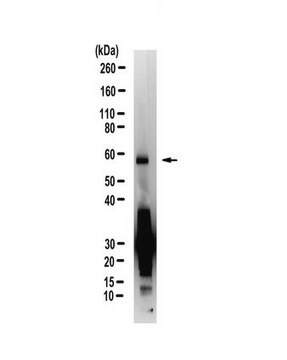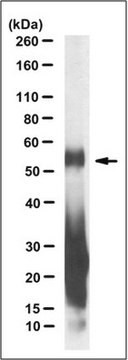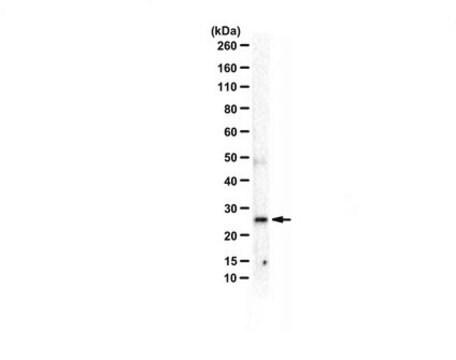ABN1360
Anti-C9ORF72 (α-GR sense Antibody, CT)
serum, from rabbit
Sinónimos:
C9orf72/C9RANT (GR sense-CT), alpha-GR-CT-sense, alpha-GR-CT, Protoein Protein C9orf72-GR-CT
About This Item
Productos recomendados
origen biológico
rabbit
Nivel de calidad
forma del anticuerpo
serum
tipo de anticuerpo
primary antibodies
clon
polyclonal
reactividad de especies
human
envase
antibody small pack of 25 μL
técnicas
dot blot: suitable
immunocytochemistry: suitable
immunofluorescence: suitable
immunohistochemistry: suitable
western blot: suitable
isotipo
IgG
Nº de acceso NCBI
Nº de acceso UniProt
Condiciones de envío
ambient
modificación del objetivo postraduccional
unmodified
Información sobre el gen
human ... C9orf72(203228)
Descripción general
Especificidad
Inmunógeno
Aplicación
Immunohistochemistry Analysis: A representative lot detected C9ORF72 (alpha-GR sense, CT) in aggregates found in neurons of the CA and DG regions of the hippocampus (Zu, T., et. al. (2013). Proc Natl Acad Sci USA. 110(51):E4968-77).
Immunocytochemistry Analysis: A 1:500 dilution from a representative lot detected C9ORF72 (alpha-GR sense, CT) in V5-GR-Ct transfected HEK293 (Courtesy of Dr Laura P.W. Ranum and Dr. Lien Nguyen from the University of Florida)..
Dot Blot Analysis: A representative lot detected C9ORF72 (alpha-GR sense, CT) in Dot blots containing frontal cortex lysates from different C9(-) and different C9(+) ALS/frontotemporal dementia (FTD) patients (Zu, T., et. al. (2013). Proc Natl Acad Sci USA. 110(51):E4968-77).
Western Blotting Analysis: A representative lot detected C9ORF72 (alpha-GR sense, CT) in Western Blotting applications (Zu, T., et. al. (2013). Proc Natl Acad Sci USA. 110(51):E4968-77).
Neuroscience
Calidad
Western Blotting Analysis: A 1:1,000 dilution of this antibody detected C9ORF72 (alpha-GR sense, CT) in V5-GR-CT transfected HEK293 cell lysate.
Descripción de destino
Forma física
Almacenamiento y estabilidad
Otras notas
Cláusula de descargo de responsabilidad
¿No encuentra el producto adecuado?
Pruebe nuestro Herramienta de selección de productos.
Código de clase de almacenamiento
12 - Non Combustible Liquids
Clase de riesgo para el agua (WGK)
WGK 1
Punto de inflamabilidad (°F)
Not applicable
Punto de inflamabilidad (°C)
Not applicable
Certificados de análisis (COA)
Busque Certificados de análisis (COA) introduciendo el número de lote del producto. Los números de lote se encuentran en la etiqueta del producto después de las palabras «Lot» o «Batch»
¿Ya tiene este producto?
Encuentre la documentación para los productos que ha comprado recientemente en la Biblioteca de documentos.
Nuestro equipo de científicos tiene experiencia en todas las áreas de investigación: Ciencias de la vida, Ciencia de los materiales, Síntesis química, Cromatografía, Analítica y muchas otras.
Póngase en contacto con el Servicio técnico








